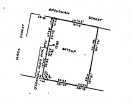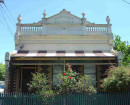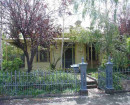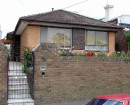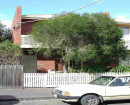BILTMORE (ST KILDA)
36 EILDON ROAD ST KILDA, PORT PHILLIP CITY
-
Add to tour
You must log in to do that.
-
Share
-
Shortlist place
You must log in to do that.
- Download report


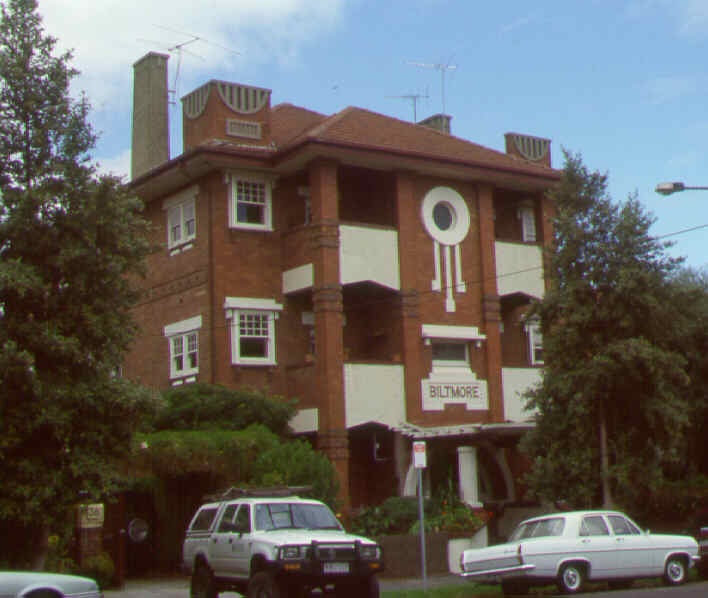
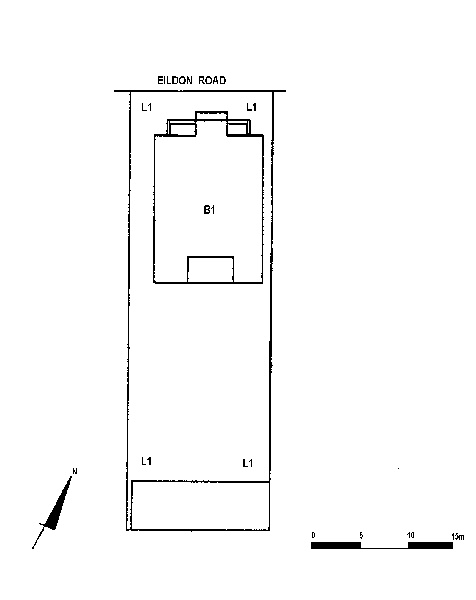
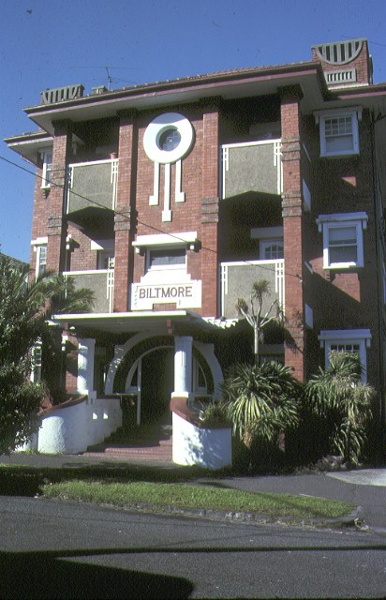
Statement of Significance
Biltmore was constructed in 1922-23 by Dunlop Home Builders, a firm of prolific home builders. Biltmore, a three-storey red brick building topped by a hipped roof clad in terracotta tiles with wide overhanging eaves, is Arts and Crafts in style with oriental influences. The most distinctive element of the building is the projecting hipped bay of the front facade with its unusual decorative treatment. The projection comprises four thin brick piers from ground to eaves with spandrel panels dividing the side bays to form balconies. The central bay has a finely detailed “Cyclops eye” central ocular window. The verticality of the structure is highlighted by two small vertical projections emerging from the roof at each corner of the front facade. The entrance archway has terracotta detailing, timber doors with oval glass and a pergola supported by two stout columns.
How is it significant?
Biltmore is of architectural and historical significance to the state of Victoria.
Why is it significant?
Biltmore is of architectural significance for its highly distinctive design and decorative features. The design and decoration, together with the skilful facade composition combining contrasts of solid and void, mass and volume, with bold verticality produces one of the most distinctive apartment blocks in Melbourne. Important features include the entrance with its archway and pergola roof; and the flat central panel of the facade with its central ocular window and rendered decoration contrasted with the deep voids of the flanking verandahs with their finely rendered balustrades and contrasting strapwork. These motifs together with the deep overhanging eaves combine to give an oriental character to the facade, an allusion which is reinforced by the profiled cantilevered timbers of the entrance pergola.
Biltmore is historically significant as a substantially intact example of an early apartment block located in St Kilda, a suburb associated with a high density of flat development since post-World War I. Biltmore retains significant original features including staircase, fireplaces, pantry cupboards, letterboxes, and milk and bread hatches.
-
-
BILTMORE (ST KILDA) - History
Contextual History:
The opening of the Melbourne and St Kilda Railway in 1857 enhanced St Kilda’s development as a fashionable seaside resort and as a residential suburb. It was considered one of the most prestigious locations in Melbourne with many fine mansions built on St Kilda Hill. The 1890s financial crash saw an exodus of St Kilda’s wealthier residents to the eastern suburbs and many mansions were converted to boarding houses. After World War I, St Kilda became a popular area for flat development.
History of Place:
According to the 1922-1923 St Kilda Rate Books, Biltmore was being built in December 1922. Its owner was F White, 325 Flinders Lane, Melbourne, although this has a question mark next to it so there was obviously some doubt about this. The following year the owner is given as F White with the occupier being Kenneth Culpan, agent. Net Annual Value was £110.
Biltmore first appears in Sands & McDougall’s Melbourne and Suburbs Directory in 1924. Five people are listed as dwelling in the flats, one of them is F White, another one is Kenneth Culpan. Eildon Road does not appear in the Sands & McDougall directories until 1924, presumably this road was created in about 1922 (when the flats were built) as a result of the subdivision of Eildon, the mansion in Grey Street.
The Australian Home Beautiful of 15 October 1925 states that Biltmore was constructed by Dunlop Home Builders.BILTMORE (ST KILDA) - Assessment Against Criteria
Criterion A
The historical importance, association with or relationship to Victoria's history of the place or object.
Biltmore is historically significant for its associations with St Kilda, an early seaside resort and prestigious residential location in Melbourne. Biltmore is one of the early apartment blocks in St Kilda which after World War I became a popular location for flat development.
Biltmore is significant as an early block of flats in Melbourne.Criterion B
The importance of a place or object in demonstrating rarity or uniqueness.Criterion C
The place or object's potential to educate, illustrate or provide further scientific investigation in relation to Victoria's cultural heritage.Criterion D
The importance of a place or object in exhibiting the principal characteristics or the representative nature of a place or object as part of a class or type of places or objects.Criterion E
The importance of the place or object in exhibiting good design or aesthetic characteristics and/or in exhibiting a richness, diversity or unusual integration of features.
Biltmore is of importance for its highly distinctive design and decorative features. The design is an eclectic mix of Arts and Crafts with an oriental influence. The design and decoration, together with the skilful facade composition combining contrasts of solid and void, mass and volume, with bold verticality produces one of the most distinctive apartment blocks in Melbourne. Important features include the contrast of the flat central panel of the facade with its central ocular window and rendered decoration with the deep voids of the flanking verandahs with their finely rendered balustrades and contrasting strapwork.Criterion F
The importance of the place or object in demonstrating or being associated with scientific or technical innovations or achievements.Criterion G
The importance of the place or object in demonstrating social or cultural associations.Criterion H
Any other matter which the Council considers relevant to the determination of cultural heritage significanceBILTMORE (ST KILDA) - Permit Exemptions
General Exemptions:General exemptions apply to all places and objects included in the Victorian Heritage Register (VHR). General exemptions have been designed to allow everyday activities, maintenance and changes to your property, which don’t harm its cultural heritage significance, to proceed without the need to obtain approvals under the Heritage Act 2017.Places of worship: In some circumstances, you can alter a place of worship to accommodate religious practices without a permit, but you must notify the Executive Director of Heritage Victoria before you start the works or activities at least 20 business days before the works or activities are to commence.Subdivision/consolidation: Permit exemptions exist for some subdivisions and consolidations. If the subdivision or consolidation is in accordance with a planning permit granted under Part 4 of the Planning and Environment Act 1987 and the application for the planning permit was referred to the Executive Director of Heritage Victoria as a determining referral authority, a permit is not required.Specific exemptions may also apply to your registered place or object. If applicable, these are listed below. Specific exemptions are tailored to the conservation and management needs of an individual registered place or object and set out works and activities that are exempt from the requirements of a permit. Specific exemptions prevail if they conflict with general exemptions. Find out more about heritage permit exemptions here.Specific Exemptions:General Conditions:
1. All exempted alterations are to be planned and carried out in a manner which prevents damage to the fabric of the registered place or object.
2. Should it become apparent during further inspection or the carrying out of alterations that original or previously hidden or inaccessible details of the place or object are revealed which relate to the significance of the place or object, then the exemption covering such alteration shall cease and the Executive Director shall be notified as soon as possible.
3. If there is a conservation policy and plan approved by the Executive Director, all works shall be in accordance with it.
4. Nothing in this declaration prevents the Executive Director from amending or rescinding all or any of the permit exemptions.
Nothing in this declaration exempts owners or their agents from the responsibility to seek relevant planning or building permits from the responsible authority where applicable.
Exterior:
* Minor repairs and maintenance which replace like with like.
* Removal of extraneous items such as air conditioners, pipe work, ducting, wiring, antennae, aerials etc, and making good.
* Installation or repair of damp-proofing by either injection method or grouted pocket method.
* Repair or replacement of timber paling fences and gates.
* Regular garden maintenance.
* Installation, removal or replacement of garden watering systems.
Common areas (roof, roof space, exterior and interior lobbies, landings and stairwells, stairs and fire escape landings and stairs):
* Minor repairs and maintenance which replace like with like.
* Painting of previously painted walls and ceilings provided that preparation or painting does not remove evidence of the original paint or other decorative scheme.
* Removal of paint from originally unpainted or oiled joinery, doors, architraves, skirtings and decorative strapping.
* Installation, removal or replacement of carpets and/or flexible floor coverings.
* Installation, removal or replacement of curtain track, rods, blinds and other window dressings.
* Installation, removal or replacement of electrical wiring provided that all new wiring is fully concealed and any original light switches, pull cords, push buttons or power outlets are retained in-situ. Note: if wiring original to the place was carried in timber conduits then the conduits should remain in-situ.
* Installation, removal or replacement of bulk insulation in the roof space.
* Installation, removal or replacement of smoke detectors.
Interior of individual flats:
* All interior alterations are permit exempt, excluding structural alterations and removal of remaining original features such as fireplaces, mantles, and glass doors to verandahs, provided such work has no effect on the exterior of the buildings.BILTMORE (ST KILDA) - Permit Exemption Policy
The purpose of the permit exemptions is to allow works that do not impact on the significance of the place to occur without the need for a permit. The exterior of the building is an integral element to the significance of the place. Alterations that impact on the significance of the exterior are subject to permit applications. Alterations to the interiors of individual flats, excluding structural alterations and removal of original features, are permit exempt.
-
-
-
-
-
LINDEN
 Victorian Heritage Register H0213
Victorian Heritage Register H0213 -
HALCYON
 Victorian Heritage Register H0775
Victorian Heritage Register H0775 -
FORMER PRIORY LADIES SCHOOL
 Victorian Heritage Register H0726
Victorian Heritage Register H0726
-
10 Down Street
 Yarra City
Yarra City
-
-






